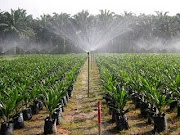Palm Plantations Of Australia
Palm Plantations of Australia is a world leader in sustainable palm oil plantation development, management, palm seed production and export since the establishment of its first plantations in 1996. It was the first company in Australia to establish plantations specifically for the production of palm seed.
Oil Palm Comparison
A comparison between SIRIM (Malaysian Govt Palm Oil Seed Certifying Authority) and our minimum qualifying requirement with regards to the mother palm and progeny (offspring) performance is given below.
SIRIM Min Standard | Our Super Yield | |
| Minimum Dura Yield | 160kg | 250kg |
| Oil to Bunch | 16% | 18% |
| Oil Yield / Palm | 25.6kg | 45kg |
| Min Progeny Yield | 160kg | 250kg |
| Oil to Bunch | 24% | 27% |
| Progeny Oil Yield / Palm | 38.4kg | 67.5kg |
| Minimum Kernel Yield | 3% | 5% |
| Oil Yield/Ha (136 Palms) | 5.22 tonns | 9.18 tons |
| Oil Yield/Ha (156 Palms) | 10.5 tons |
The extra oil yield (5.28ton) at USD$900/ton will earn an extra USD$4750/Ha every year.
Certified Oil Palm Field Trial - 125 Hectares
19th-24th month Yield/Ha 7.54tons
25th-36th month Yield/Ha 10.61tons
37th-48th month Yield/Ha 20.28tons
49th-60th month Yield/Ha 25.27tons
61st-72nd month Yield/Ha 35.65tons
Higher ratio of female flowers
Our oil palms have been critically culled for over 20 years for nearly 100% female flowers.
Higher bunch weights
Our oil palm bunches provide yields over six kilograms above the industry average.
Higher bunch numbers
Our oil palms consistently produce an average 16 bunches per tree per year from Year 2.
Higher oil to bunch ratio
Our oil palms achieve above 32% oil to bunch ratio when industry average of only 25% is achieved.
Higher oil recovery
Our oil palms produce more oil within fruits when compared to industry standards.
Higher Density Planting
Our Oil Palms have shorter more erect fronds making it possible to plant 156 trees/hectare as compared with industry standard of 132 oil palms/hectare.
Tissue Cultured Material
We are entering the Biotechnology field with the construction of a tissue culture laboratory. Tissue Culture enables replication of individual high performing Palm in large scale and shorter time. Tissue Culture ensures that ramets(offspring) produced are identical to that of the original palm.
Traits such as higher oil/bunch is highly heritable and transferable to the next generation. An improvementof 20-30%oil yield can be expected over conventional DxP planting material.
Find more details >>> http://www.palmplantations.com.au/oil-palm-seeds.htm




